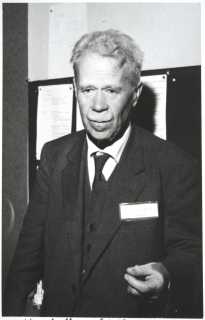Yrjö Väisälä
| Yrjö Väisälä | |
|---|---|
 | |
| Born |
September 6, 1891 Utra, Finland |
| Died |
July 21, 1971 (aged 79) Rymättylä, Finland |
| Nationality | Finnish |
| Fields | astronomy, physics |
Yrjö Väisälä [ˈyrjø ˈʋæisælæ] (![]() ) (6 September 1891[1] – 21 July 1971) was a Finnish astronomer and physicist.
) (6 September 1891[1] – 21 July 1971) was a Finnish astronomer and physicist.
His main contributions were in the field of optics, but he was also very active in geodetics, astronomy and optical metrology. He had even an affectionate nickname of Wizard of Tuorla (Observatory/Optics laboratory), and there is a book with the same title in Finnish describing his works.
His brothers were mathematician Kalle Väisälä and meteorologist Vilho Väisälä.
Väisälä was also a fervent supporter of Esperanto, presiding the Internacia Scienca Asocio Esperantista ("International Association of Esperanto Scientists") in 1968.[2]
Optician
He developed several methods for measuring the quality of optical elements, as well as a lot of practical methods of manufacturing said elements.
This allowed the construction of some of the earliest high-quality Schmidt cameras, in particular a "field-flattened" version known as Schmidt-Väisälä camera.
Contemporary to Bernhard Schmidt's design, but unpublished was also Prof. Yrjö Väisälä's identical design which he had mentioned in lecture notes in 1924 with a footnote: "problematic spherical focal surface".
Once he saw Schmidt's publication, he promptly went ahead and "solved" the field flattening problem by placing a doubly convex lens slightly in front of the film holder (back in the 1930s, astronomical films were glass plates.) The resulting system is known as the Schmidt-Väisälä camera or sometimes as the Väisälä camera. (This solution is not perfect, as images of different colour end up at slightly different places.)
Prof. Väisälä made a small test unit of 7 mirrors in a mosaic on stiff background steel frame, however it proved to be impossible to stabilize as "just adjust and forget" structure, and next time anybody tried it, was with active controls on Multiple Mirror Telescope.
Geodesy
In the 1920s and 1930s Finland was doing its first precision triangulation chain measurements, and to create long-distance vertices Prof. Väisälä proposed usage of flash-lights on 5 to 10 kilometres (16,000 to 33,000 ft) altitude balloons, or on some big fireworks rockets. The idea was to measure the exact position of the flash against background stars, and by precisely knowing one camera location, to derive an accurate location for another camera. This required better wide-field cameras than were available, and was discarded.
Later, Prof. Väisälä developed a method to multiply an optical length reference using white light interferometry to precisely determine lengths of baselines used in triangulation chains. Several such baselines were created in Finland for second high-precision triangulation campaign in 1950s and 1960s.
Later GPS made these methods largely obsolete. A Väisälä interferometry baseline is still maintained by the Finnish Geodetic Institute in Nummela for the calibration of other distance measurement instruments.
Prof. Väisälä also developed excellent tools to measure earth rotational axis position by building so called zenith telescopes, and in the 1960s Tuorla Observatory was in the top rank of North Pole position tracking measurements.
In the 1980s radioastronomy was able to replace earth rotation tracking by referring things against "non-moving background" of quasars.
For these Zenith Telescopes, Prof. Väisälä made also one of the first experiments at doing mirrors of liquid mercury. (Such mirror needs extremely smooth rotational speeds which were achieved in the late 1990s.)
Astronomer
The big Schmidt-Väisälä telescope he built was used at the University of Turku for searching asteroids and comets. His research group discovered 7 comets and 807 asteroids.
For this rather massive photographic survey work, Prof. Väisälä developed also a protocol of taking two exposures on same plate some 2–3 hours apart and offsetting those images slightly. Any dot-pairs that differed from background were moving, and deserved follow-up photos. This method halved the film consumption compared to method of "blink comparing", where plates get single exposures, and are compared by rapidly showing first and second exposures to human operator. (Blink-comparing was used to find e.g. Pluto.)
Notably, Yrjö Väisälä discovered the periodic comets 40P/Väisälä and 139P/Väisälä-Oterma (the latter was co-discovered with Liisi Oterma and at first classified as asteroid 1939 TN).
The University of Turku Astronomy department is known as VISPA: Väisälä Institute for Space Physics and Astronomy (http://www.astro.utu.fi/) in honour of its founder.
The crater Väisälä on the Moon is named after him, and so are the asteroids 1573 Väisälä and 2804 Yrjö.
Asteroids discovered
Yrjö Väisälä discovered 128 asteroids. He used to name them with the names of his personal friends that had birthdays. One of them was the professor Matti Palomaa, after whom an asteroid 1548 Palomaa was named. For this reason the Palomar Mountain Observatory in California has never had an asteroid bearing its name – the rules for naming asteroids state that the names have to differ from each other with more than one letter.
References
- ↑ The birth date is a Gregorian calendar date. Although Finland was part of the Russian Empire at the time and Russia used the Julian calendar until 1918, the Gregorian calendar continued in official use in Finland because Finland had been part of Sweden when Sweden had converted to the Gregorian calendar in 1753.
- ↑ Esperanta Finnlando numero 1/1968
|